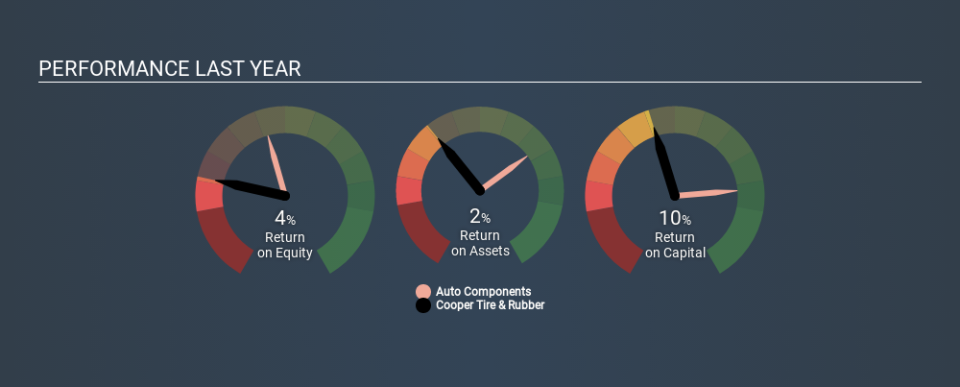Why You Should Care About Cooper Tire & Rubber Company’s (NYSE:CTB) Low Return On Capital

Today we are going to look at Cooper Tire & Rubber Company (NYSE:CTB) to see whether it might be an attractive investment prospect. To be precise, we'll consider its Return On Capital Employed (ROCE), as that will inform our view of the quality of the business.
First of all, we'll work out how to calculate ROCE. Then we'll compare its ROCE to similar companies. Last but not least, we'll look at what impact its current liabilities have on its ROCE.
Understanding Return On Capital Employed (ROCE)
ROCE measures the 'return' (pre-tax profit) a company generates from capital employed in its business. In general, businesses with a higher ROCE are usually better quality. Ultimately, it is a useful but imperfect metric. Renowned investment researcher Michael Mauboussin has suggested that a high ROCE can indicate that 'one dollar invested in the company generates value of more than one dollar'.
So, How Do We Calculate ROCE?
Analysts use this formula to calculate return on capital employed:
Return on Capital Employed = Earnings Before Interest and Tax (EBIT) ÷ (Total Assets - Current Liabilities)
Or for Cooper Tire & Rubber:
0.10 = US$192m ÷ (US$2.7b - US$765m) (Based on the trailing twelve months to September 2019.)
Therefore, Cooper Tire & Rubber has an ROCE of 10.0%.
View our latest analysis for Cooper Tire & Rubber
Does Cooper Tire & Rubber Have A Good ROCE?
One way to assess ROCE is to compare similar companies. We can see Cooper Tire & Rubber's ROCE is meaningfully below the Auto Components industry average of 14%. This could be seen as a negative, as it suggests some competitors may be employing their capital more efficiently. Regardless of where Cooper Tire & Rubber sits next to its industry, its ROCE in absolute terms appears satisfactory, and this company could be worth a closer look.
Cooper Tire & Rubber's current ROCE of 10.0% is lower than its ROCE in the past, which was 22%, 3 years ago. So investors might consider if it has had issues recently. You can see in the image below how Cooper Tire & Rubber's ROCE compares to its industry. Click to see more on past growth.
Remember that this metric is backwards looking - it shows what has happened in the past, and does not accurately predict the future. Companies in cyclical industries can be difficult to understand using ROCE, as returns typically look high during boom times, and low during busts. ROCE is only a point-in-time measure. What happens in the future is pretty important for investors, so we have prepared a free report on analyst forecasts for Cooper Tire & Rubber.
Do Cooper Tire & Rubber's Current Liabilities Skew Its ROCE?
Short term (or current) liabilities, are things like supplier invoices, overdrafts, or tax bills that need to be paid within 12 months. Due to the way the ROCE equation works, having large bills due in the near term can make it look as though a company has less capital employed, and thus a higher ROCE than usual. To counteract this, we check if a company has high current liabilities, relative to its total assets.
Cooper Tire & Rubber has current liabilities of US$765m and total assets of US$2.7b. As a result, its current liabilities are equal to approximately 28% of its total assets. Current liabilities are minimal, limiting the impact on ROCE.
The Bottom Line On Cooper Tire & Rubber's ROCE
Overall, Cooper Tire & Rubber has a decent ROCE and could be worthy of further research. Cooper Tire & Rubber shapes up well under this analysis, but it is far from the only business delivering excellent numbers . You might also want to check this free collection of companies delivering excellent earnings growth.
If you are like me, then you will not want to miss this free list of growing companies that insiders are buying.
If you spot an error that warrants correction, please contact the editor at editorial-team@simplywallst.com. This article by Simply Wall St is general in nature. It does not constitute a recommendation to buy or sell any stock, and does not take account of your objectives, or your financial situation. Simply Wall St has no position in the stocks mentioned.
We aim to bring you long-term focused research analysis driven by fundamental data. Note that our analysis may not factor in the latest price-sensitive company announcements or qualitative material. Thank you for reading.

 Yahoo Finance
Yahoo Finance 
